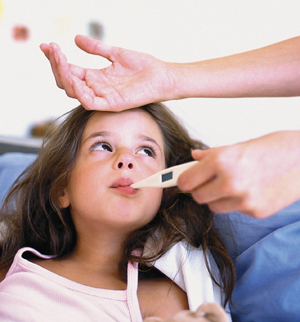Fever in Children
Fever in Children
A fever is a natural reaction of the body to an illness, such as infections from viruses or bacteria. In most cases, the fever itself is not harmful. It actually helps the body fight infections. A fever does not need to be treated unless your child is uncomfortable and looks or acts sick. How your child looks and feels are often more important than the level of the fever.
If your child has a fever, check his or her temperature as needed. Don't use a glass thermometer that contains mercury. They can be dangerous if the glass breaks and the mercury spills out. Always use a digital thermometer when checking your child’s temperature. The way you use it will depend on your child's age. Ask your child’s healthcare provider for more information about how to use a thermometer on your child. General guidelines are:
The American Academy of Pediatrics advises that rectal temperatures are most accurate for children younger than 3 years. Accuracy is very important because babies must be seen right away by a healthcare provider if they have a fever. Be sure to use a rectal thermometer correctly. A rectal thermometer may accidentally poke a hole in (perforate) the rectum. It may also pass on germs from the stool. Always follow the product maker’s directions for proper use. If you don’t feel comfortable taking a rectal temperature, use another method. When you talk with your child’s healthcare provider, tell him or her which method you used to take your child’s temperature.
For toddlers, take the temperature under the armpit (axillary).
For children old enough to hold a thermometer in the mouth (usually around 4 or 5 years of age), take the temperature in the mouth (oral).
For children age 6 months and older, you can use an ear (tympanic) thermometer.
A forehead (temporal artery) thermometer may be used in babies and children of any age. This is a better way to screen for fever than an armpit temperature.
Comfort care for fevers
If your child has a fever, here are some things you can do to help him or her feel better:
Give fluids to replace those lost through sweating with fever. Water is best, but low-sodium broths or soups, diluted fruit juice, or frozen juice bars can be used for older children. Talk with your healthcare provider about a plan. For an infant, breastmilk or formula is fine and all that is usually needed.
If your child has discomfort from the fever, check with your healthcare provider to see if you can use ibuprofen or acetaminophen to help reduce the fever. The correct dose for these medicines depends on your child's weight. Don’t use ibuprofen in children younger than 6 months old. Never give aspirin to a child under age 18. It could cause a rare but serious condition called Reye syndrome.
Make sure your child gets lots of rest.
Dress your child lightly and change clothes often if he or she sweats a lot. Use only enough covers on the bed for your child to be comfortable.
Facts about fevers
Fever facts include the following:
Exercise, eating, excitement, and hot or cold drinks can all affect your child’s temperature.
A child’s reaction to fever can vary. Your child may feel fine with a high fever, or feel miserable with a slight fever.
If your child is active and alert, and is eating and drinking, you don't need to give fever medicine.
Temperatures are naturally lower between midnight and early morning and higher between late afternoon and early evening.
When to call your child's healthcare provider
Call the healthcare provider’s office if your otherwise healthy child has any of the signs or symptoms below:
Fever (see Fever and children, below)
A seizure caused by the fever
Rapid breathing or shortness of breath
A stiff neck or headache
Trouble swallowing
Signs of dehydration. These include severe thirst, dark yellow urine, infrequent urination, dull or sunken eyes, dry skin, and dry or cracked lips
Your child still doesn’t look right to you, even after taking a nonaspirin pain reliever
Fever and children
Always use a digital thermometer to check your child’s temperature. Never use a mercury thermometer.
Here are guidelines for fever temperature. Ear temperatures aren’t accurate before 6 months of age. Don’t take an oral temperature until your child is at least 4 years old. When you talk to your child’s healthcare provider, tell him or her which method you used to take your child’s temperature.
Infant under 3 months old:
Ask your child’s healthcare provider how you should take the temperature.
Rectal or forehead (temporal artery) temperature of 100.4°F (38°C) or higher, or as directed by the provider
Armpit temperature of 99°F (37.2°C) or higher, or as directed by the provider
Child age 3 to 36 months:
Rectal, forehead (temporal artery), or ear temperature of 102°F (38.9°C) or higher, or as directed by the provider
Armpit temperature of 101°F (38.3°C) or higher, or as directed by the provider
Child of any age:
Repeated temperature of 104°F (40°C) or higher, or as directed by the provider
Fever that lasts more than 24 hours in a child under 2 years old. Or a fever that lasts for 3 days in a child 2 years or older.
Updated:
August 09, 2018
Reviewed By:
Adler, Liora C., MD,Bass, Pat F. III, MD, MPH,Image reviewed by StayWell art team.,Pierce-Smith, Daphne, RN, MSN, CCRC,Turley, Ray, BSN, MSN
